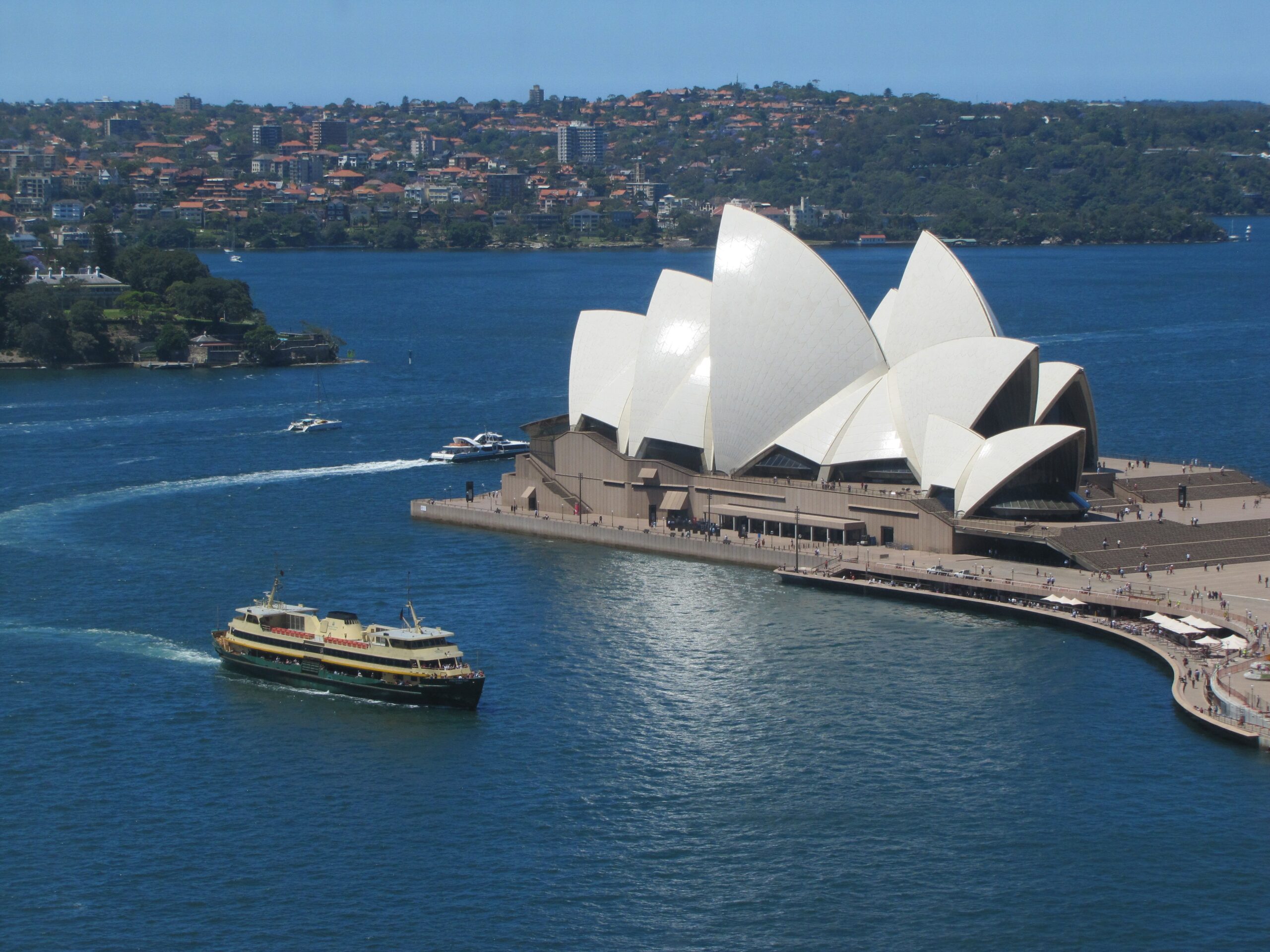Sydney is a city that harmoniously blends iconic landmarks and hidden gems, postcard beaches and trendy suburbs, top restaurants, and laid-back café culture. Whether you are an inaugural visitor or returning again to explore further, this week-long itinerary will take you to the top of Australia’s harbor city, with plenty of room for spontaneous findings in between.
Day 1: Iconic Sydney Harbor
Morning: Sydney Opera House & Circular Quay
Start your Sydney experience at the famous Opera House. Take the guided tour to learn about its distinctive architecture and history, or simply admire its sail-like shells from every side encircling Circular Quay. Have a coffee at Opera Bar with views of the harbor that can’t be beaten.
Evening: The Rocks
Visit Sydney’s historic center with cobblestone lanes, Saturday markets, and great pubs. Eat in one of the neighborhood’s highly praised restaurants such as Quay or Bennelong for a memorable first evening, or grab something to eat at the historic Hero of Waterloo pub.
Insider Tip: Book a harbor-view room if available – waking to Sydney Harbour never becomes tiresome.
Day 2: Beach Culture & Eastern Suburbs
Morning: Bondi Beach
Catch the train to Bondi Junction and bus to Australia’s famous beach. Take a surf lesson with one of the surf schools or simply soak and watch. Stare at the Bondi Icebergs Club pool perched over the rocks.
Afternoon: Bondi to Coogee Coastal Walk
This breathtaking 6km ocean cliff walk has you going by some lovely beaches such as Tamarama, Bronte, and Clovelly. All the beaches are different – Bronte being the favorite of the families but Tamarama is the “Glamarama” beach because it is where the fashionable crowd congregates.
Evening: Coogee
Finish your beach walk in laid-back Coogee. Have fish and chips at the beach or from a beach cafe. The Coogee Beach sunset is breathtaking.
Insider Tip: Pack sunscreen, water, and a good walking shoe. The coastal walk is rough in places but worth it.
Day 3: Culture & Inner City Neighborhoods
Morning: Art Gallery of New South Wales
Start with Sydney’s premier art gallery, which has a rich Australian, European, and Asian art collection. The gallery is free to visit and commands beautiful harbor views from its grounds.
Afternoon: Paddington & Surry Hills
Stroll by Paddington’s Victorian terraces and boutique shopping along Oxford Street. Then, head to trendy Surry Hills for lunch at one of its famous cafés – try Single O or Reuben Hills for top coffee culture.
Late Afternoon: Darlinghurst & Kings Cross
Walk Darlinghurst’s warren of art galleries, antique shops, and cafes. Kings Cross has cleaned itself up and is now a cool suburb with restaurants and bars to follow.
Evening: Dinner in Surry Hills
Surry Hills offers Sydney’s best dining. For award-winning wood-fired fare, eat at Firedoor, or, for casual eating, try Yellow for excellent Vietnamese.
Insider Tip: Saturday is a great day to explore Paddington Markets, held on the grounds of St. John’s Church.
Day 4: Harbor Islands & Water Activities
Morning: Ferry to Manly
Take the picturesque 30-minute ferry ride to Manly – one of the world’s most beautiful commutes. The ferry ride itself is a tourist attraction with a breathtaking harbor and Opera House scenery.
Full Day: Manly Beach & The Corso
Manly has a different beach culture from Bondi – laid back and family-centered. Surf the ocean beach, shop along The Corso, or take lessons in surfing.
Afternoon Alternative: Cockatoo Island
Or, explore Cockatoo Island in the afternoon, a UNESCO World Heritage-listed site with convict and naval history. You can camp overnight here for a remote Sydney experience.
Insider Tip: Purchase an Opal card to simplify traveling on any Sydney public transport, including ferries.
Day 5: Blue Mountains Day Trip
Early Morning: Departure for the Blue Mountains
The train travels from Central to Katoomba (2 hours). The Blue Mountains offer a dramatic visual respite from Sydney’s harbor and beaches.
Morning: Three Sisters & Echo Point
Start with the iconic Three Sisters rock formation at Echo Point. Get your photo taken, then stroll through the various walking tracks that offer alternative vistas of the natural wonder.
Late Afternoon: Leura
Enjoy tea and antiques browsing in Leura village. Leura’s charming main street is full of art galleries, antique houses, and specialty stores.
Evening: Return to Sydney
Return by train to Sydney and leave time for a late evening meal in town.
Insider Tip: Look out for the weather forecast – the Blue Mountains are usually much cooler than Sydney, especially during winter.
Day 6: Food, Markets, & Local Life
Morning: Barangaroo & Walsh Bay
Uncover Sydney’s latest waterfront precinct at Barangaroo, featuring parklands, harbor strolls, and restaurants. Follow this by strolling along the refurbished wharf buildings at Walsh Bay.
Late Morning: Sydney Fish Market
Browse the largest fish market in the Southern Hemisphere for the freshest seafood experience. Go behind the scenes with a tour or simply enjoy sushi, oysters, and fish and chips surrounded by harbor views.
Afternoon: Glebe Markets & Newtown
Walk through the offbeat Glebe Markets (only on Saturdays) for antique goodies and local crafts. And then absorb nearby Newtown’s street art, independent bookshops, and alternative culture along King Street.
Late Afternoon: Chinatown & Darling Harbour
Walk through Chinatown for authentic Asian food and culture, and next to Darling Harbour’s attractions like SEA LIFE Sydney Aquarium or otherwise enjoy the waterfront promenade.
Evening: Dinner in Chinatown
Experience Sydney’s best Asian food culture on dinner in Chinatown, or try one of the trendiest restaurants in nearby Darling Square.
Tip: Some markets have specific days – plan accordingly. Saturday is best for the market going around.
Day 7: Royal Botanic Gardens & Farewell Sydney
Morning: Royal Botanic Gardens
Spend your final morning in Sydney’s green center. The Royal Botanic Gardens offers peaceful walks, diverse plantings, and some of the city’s finest harbor vistas. Don’t miss a visit to Mrs. Macquarie’s Chair for the standard Sydney Harbor photo.
Late Morning: Farm Cove & Garden Island
Stroll along Farm Cove for changed views of the Opera House and harbor. The promenade connects the gardens with the harbor foreshore.
Afternoon: Final Harbor Experience
Your final afternoon is your choice – a harbor cruise, kayaking the harbor islands, or just taking it easy on one of the harbor beaches, such as Balmoral or Nielsen Park.
Late Afternoon: Shopping & Souvenirs
Get last-minute shopping for souvenirs at The Rocks Markets, Queen Victoria Building, or Strand Arcade. The QVB is especially lovely and home to upscale Australian labels.
Evening: Farewell Dinner
Book a harbor view restaurant for your last night’s dinner – consider Aria, Bennelong, or 6Head for special occasion dining, or go easy at Opera Bar with drinks and snacks as you watch the sunset over Sydney Harbour for the final time.
Highlights of Sydney Tips
- Getting Around: Sydney has public transport comprising trains, buses, and ferries. An Opal card makes travel easy and budget-friendly.
- Weather: Sydney weather is typically mild but fickle. Pack layers and always apply sunscreen.
- Budget: Sydney can be expensive, but there are lots of options like beaches, harbor strolls, and a few museums that are free. Have a happy hour and lunch specials.
- Safety: Sydney is generally very safe, but just exercise common sense, especially late at night in areas with a lot of people.
- Local Etiquette: Aussies are hospitable and relaxed. Tipping is not required but acknowledged for excellent service (10-15%).
Outside the Itinerary
Sydney treats you well when you venture outside the major attractions. Look at visiting the fashionable Inner West suburbs such as Balmain or Rozelle, discovering northern beaches such as Dee Why or Avalon, or doing a day’s outing to the Hunter Valley wine region if you can spare the time.
Remember, this is a guide – Sydney’s charm lies in the surprise factor. Leave room for enough random discovery, be it a hidden café, an unplanned beach day, or even just a harbor day, and sit and watch the world go by. After a week, you’ll know why Sydneysiders love their beautiful harbor city.
Safe travels, and Sydney adventures!
Top 6 Questions and Answers Before Visiting Australia
Planning a trip to Australia? Here are some of the most frequently asked questions on Google and their answers to help you prepare for your visit:
1. What are the entry requirements for Australia?
To enter Australia, you need a valid visa or an Electronic Travel Authority (ETA), depending on your nationality. Check the Australian Government’s Department of Home Affairs website for the most up-to-date information and to apply online. Ensure your passport is valid for at least six months beyond your planned departure date.
2. What is the best time to visit Australia?
The best time to visit Australia depends on the region and the activities you plan to do. Generally, the spring (September to November) and autumn (March to May) offer mild weather and fewer tourists. For tropical northern regions, visit during the dry season (May to October), while southern areas are ideal in the summer (December to February).
3. How can I travel around Australia?
Australia has a comprehensive transportation network. Domestic flights are the quickest way to cover long distances between major cities. For shorter trips, consider renting a car, taking trains, or using long-distance buses. Within cities, public transport options like buses, trams, and trains are efficient and widely available. Check out Transport NSW for more information on public transportation in New South Wales.
4. Is Australia safe for travelers?
Australia is generally very safe for travelers, with a low crime rate. However, be aware of natural hazards such as bushfires, extreme heat, and dangerous wildlife like snakes and spiders. Always follow local advice and stay informed about current conditions.
5. What currency is used in Australia, and can I use credit cards?
Australia uses the Australian Dollar (AUD). Credit and debit cards are widely accepted, and ATMs are available throughout the country. It’s a good idea to carry some cash for use in more remote areas or smaller establishments. Currency exchange services are available at airports, banks, and exchange bureaus.
6. Do I need travel insurance for Australia?
While travel insurance is not mandatory, it is highly recommended. Travel insurance can cover medical expenses, trip cancellations, lost luggage, and other unexpected costs. Healthcare in Australia can be expensive for visitors, so having insurance provides peace of mind. Compare plans and choose one that best fits your needs.
These answers should help you prepare for a smooth and enjoyable trip to Australia. Always check official sources for the latest information and updates before you travel.
Work and Live in Australia with Alliance Visas
Are you dreaming of starting a new chapter in Australia? With Alliance Visas, your dream can become a reality. Specializing in visa applications and immigration services, Alliance Visas provides comprehensive support to help you navigate the complexities of moving to Australia. Whether you’re seeking employment opportunities, planning to study, or aiming to settle with your family, Alliance Visas offers tailored solutions to meet your specific needs. Let their expertise guide you through the process, ensuring a smooth transition to your new life Down Under. Explore your options and start your Australian adventure today with Alliance Visas.Contact us at info@alliancevisas.com or fill in the assessment below:
[assessment_form]



